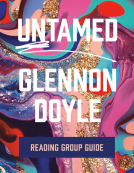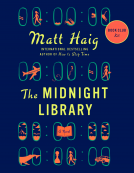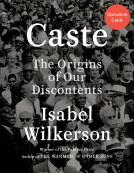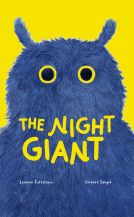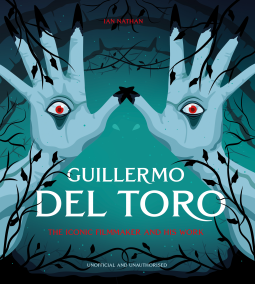
Guillermo del Toro
The Iconic Filmmaker and his Work
by Ian Nathan
This title was previously available on NetGalley and is now archived.
Send NetGalley books directly to your Kindle or Kindle app
1
To read on a Kindle or Kindle app, please add kindle@netgalley.com as an approved email address to receive files in your Amazon account. Click here for step-by-step instructions.
2
Also find your Kindle email address within your Amazon account, and enter it here.
Pub Date Nov 09 2021 | Archive Date Nov 24 2021
Quarto Publishing Group – White Lion | White Lion Publishing
Talking about this book? Use #GuillermodelToro #NetGalley. More hashtag tips!
Description
Widely regarded as one of the most imaginative directors working in cinema today, Guillermo del Toro has built up a body of work that has enthralled movie fans with its dark beauty and edge-of-the-seat set pieces.
In this book, acclaimed author Ian Nathan charts the progression of a career that has produced some of contemporary cinema’s most revered scenes and idiosyncratic characters. This detailed examination looks at how the strands of del Toro’s career have woven together to create one of modern cinema’s most ground-breaking bodies of work.
Delving deep into del Toro's psyche, the book starts by examining his beginnings in Mexico, the creative but isolated child surrounded by ornate catholicism and monster magazines, filming stop motion battles between his toys on a Super-8 film camera.
It follows him to film school, where we learn of his influences, from Kafka to Bunuel, and explores his 1993 debut Cronos, the independent horror debut which draws on the religious and occult themes which would recur throughout del Toro's work.
It goes on to cover his development as a director with 1997's Mimic, his blockbuster success with the Hellboy films and goes on to study the films which have cemented his status as a legendary auteur, Oscar award winners Pan's Labrynth and The Shape of Water, as well as his sci-fi masterpiece Pacific Rim, as well as looking at his exciting upcoming projects Nightmare Alley and Pinocchio.
An enlightening look into the mind of an auteur blessed with a singular creative vision, Guillermo del Toro analyses the processes, themes and narratives that have come to be recognised as distinctly del Toro, from practical effects to an obsession with folklore and paganism. It looks into the narrative techniques, stylistic flourishes and creative decisions which have made him a true master of modern cinema.
Presented in a slipcase with 8-page gatefold section, with scores of illuminating photographs of the director at work on set as well as iconic stills from his films and examples of his influences, this stunning package will delight all Guillermo del Toro devotees and movie lovers in general.
Unauthorised and Unofficial.
Available Editions
| EDITION | Other Format |
| ISBN | 9780711263284 |
| PRICE | $39.99 (USD) |
| PAGES | 176 |
Average rating from 36 members
Featured Reviews
What an exceptional and fascinating glimpse into the world of such a visionary Director.
I have loved Guillermo del Toro for many years now and can remember my first love being his film Cronos and so getting to read this, albeit unofficial, has been a lovely journey through the mind and creative genius that is Guillermo del Toro.
It is amazing to get an insight into the things that influenced him such as life growing up in Mexico, his religion/religious beliefs, the relationships with his family, and the real-life horrors he witnessed and was subjected to.
We also get to read about how he found his love of film, starting as a film critic, learning aspects of his craft from legends of the industry, all the way to his Directorial debut and his Oscar win.
This book is also filled with stunning scenes from his films including the heartbreakingly beautiful Pans Labyrinth and also the spectacular The Shape of Water. And not to forget, the iconic posters and pictures from many a classic horror movie, that can be felt and seen reflected in his work.
The man is undoubtedly a living legend with a mind that is filled with terror, darkness, pain, but also such beauty, humour, and kindness. He is truly one of a kind.
The limits of this man's mind are endless. He is able to take such contrasting ideas/genres like folklore, fairytale, and horror, fuse them together to then create the mesmerizing wonders we see on our screens. It's absolutely mind-blowing.
I really enjoyed reading more about my favourite director and seeing the stunning images that accompany this book.
Thank you so much to NetGalley & White Line Publishing (an imprint of The Quarto Group)
My review will be on my bookstagram account (piggindani_reads) & Amazon.
Please forgive me, I don’t know how to link these pages xo
A celebration of one of my favourite directors, Guillermo del Toro: The Iconic Filmmaker and His Work is a perfect gift for any cinema lover – an artistically beguiling and brilliantly researched biography that explores the fantastical imagination of a true master of modern cinema.
Beginning in Mexico where del Toro grew up as a creative but isolated child, the book looks at his early influences and experiences then goes on to examine his filmography, from his 1993 debut Cronos to his Oscar award-winning Pan’s Labyrinth and The Shape of Water, leading up to his upcoming projects, Nightmare Alley and Pinocchio.
The book also includes many photographs of the director at work on set as well as iconic stills from his films. These alone make for a fascinating read as del Toro’s films are always so strikingly aesthetic. From the swampy-hued set designs contrasting with splashes of blood-red, the superior practical effects, to the nightmarish monsters that come from del Toro’s obsession with folklore and paganism, his films are always a piece of art in themselves.
I really enjoyed getting to do know more about a director that I love, learning about his influences, and getting some masterful insight on some of my favourite films.
If you love gothic historical tales and dark fairytales, I thoroughly recommend checking out some of del Toro’s work if you haven’t already.
Guillermo del Toro is a beautiful, coffee table style book about the director’s early life and filmography. This book is a must read for any del Toro fan, as well as anyone who enjoys horror, weird things and cinema in general.
The book begins with a brief background of del Toros’s early life and explores his early love of film and monsters in general. From there each chapter highlights a different del Toro movie chronologically. The inspiration, filming struggles and del Toro’s general feelings about each film are addressed in each chapter. I loved delving into each of del Toro’s films. I’m a big fan of his work, but reading this book allowed me to pause and reflect on each movie individually. It was very interesting to see how politics, artwork and history have all influenced this writer/director in all of his works. It was also interesting to read about Guillermo’s relationships with other directors. The chapter about Pan’s Labyrinth was great and I enjoyed reading about his friendship with Alfonso Cuarón.
The photos in this book were beautiful. I loved the mix of classic horror/vintage posters with shots from del Toro’s own movies. One of the reasons I love his movies so much is because I know he is such a fan of the classics and puts his passion into it. All in all this book was a really lovely tribute and I can’t wait to see his future projects.
Thanks so much to NetGalley and the publisher for an advanced copy.
Guillermo del Toro is a book sure to delight any fan of the imaginative director. It opens with an overview of del Toro's early life, before launching into discussions of each of his major movies in chronological order, incorporating some wonderful movie stills and behind-the-scenes images, along with information on the background of each of the films. It is a pleasing, compact review of his life and body of work so far. If I have a single criticism it's that the book is too short; I would have liked even more detail on the motifs in his movies and his creative process for each. Overall, this book gets 4.5 stars from me. If you are a fan of del Toro's movies, or a film buff in general, you will find this book well worth a read.
 Kim D, Reviewer
Kim D, Reviewer
trigger warning
<spoiler> mention of drug addiction, mention of violence and trauma </spoiler>
This is a beautiful coffee table book about Guillermo del Toro and his art. We have a short introduction to how he wound up getting into the field, and then the chapters are sorted into the big movies, Hellboy 1 and 2 sharing a chapter, as do Nightmare Alley and Pinocchio.
I chose to not mark this as fully read because I leafed through this, reading some chapters, then ignoring some about movies I haven't seen yet.
We have footnotes and pictures from the movies, or from exhibitions.
You see the author's love of Guillermo del Toro's work on every single page.
If you're looking for a gift and know the person you've in mind shares said love, this would be a great pick.
The arc was provided by the publisher.
 Dan O, Bookseller
Dan O, Bookseller
My thanks to NetGalley and the publisher Quarto Publishing Group- White Lion for an advanced copy of this coffee table memoir and film study.
One of the very film directors that the word 'visionary' actually seems made for is the director- writer- sculptor- painter- and more Guillermo del Toro. Besides "visionary" maybe he word 'multi- hyphenate' is fitting. In the new coffee table book Guillermo del Toro: The Iconic Filmmaker and his Work, author Ian Norman, follows the director from his childhood in Guadalajara, Mexico to his newest planned films.
The book is lavishly illustrated with film posters, film stills, paintings, books, comics, and pictures of his own collection, which once merited a book of its own. Though the book is unoffical and unauthorized the author has done a very good job and researching and trying to get deep into Mr. del Toro and to find what makes him tick. Be it his early days filling notebooks with ideas for his first movie Chronos, or the pain of learning about Hollywood via his soul crushing work on the movie Mimic, Mr. Norman has really created a fine narrative explaining much about the director and how he traveled from genre films, to world cinema, to Oscar winning director.
A beautiful book for serious fans. Some of the stories might not be new, and some of the pictures of the collection might be familiar, but this is one of the better books on a director that really has changed film and challenged audiences with movies that are not only visually stunning, but thoughtful and emotional. Plus he made Blade 2. That movies was awesome. this book is a true treat for any cinephile.
 Bookseller 732304
Bookseller 732304
Very well done little biographies and and some sort of filmography as well in some way. It also has a lot of great picture in it to make it the perfect coffee table book for the Del Toro fans!!
Fans of Guillermo del Toro are sure to find this book fascinating. After a brief introduction, we jump right into an examination of Guillermo’s filmography. However, it’s not just a cut and dry examination of each film. There is an in-depth look Guillermo’s childhood, his beliefs, and experiences that sculptured him into the man he has become, how those experiences influenced his work and shaped him into the filmmaker he has become. Exploring the highs and the lows of his career, from the brilliance of Pan’s Labyrinth (my personal favorite of all his films) to the his absolute hatred of his experience filming Mimic. We even get a chance to examine two of his upcoming films: Nightmare Alley and Pinocchio.
This was a fascinating look at one of my favorite filmmakers, but I must admit this one was a bit hard to review. Why? Because I’m reviewing this book on my phone as an eARC, while the actual book rerelease will be as a coffee table book. There is no question the full-sized book is how this book should and is meant to be experienced, if for no other reason than to truly be able to appreciate some of the stunning photographs.
I’d like to thank Quatro Publishing Group - White Lion and NetGalley for the opportunity to read and review Guillermo del Toro: The Iconic Filmmaker and his Work.
 Victoria I, Media/Journalist
Victoria I, Media/Journalist
For fans who can't get enough of Guillermo del Toro's unique dark style, this new book by Ian Nathan is a great place to start. Starting with del Toro's childhood in Mexico and the aesthetics of his upbringing, the book goes to film school with the director, and shows how independent horror would inspire him to create some of the amazing visuals for Mimic, Hellboy, Pan's Labyrinth, The Shape of Water, and Pacific Rim.
Guillermo del Toro: The Iconic Filmmaker and His Work is full of pictures, stories of practical effects, and the themes that seem to travel though his work. This edition comes in a slipcase, has an 8-page goldfoil section with a ton of photographs, and acts as a centerpiece for a movie-buff's guides. The book retails at $35 and it is MASSIVE. This is one of those books I'd recommend getting in print versus digital.
Guillermo del Toro: The Iconic Filmmaker and His Work is available now.
A Man of Many Monster Movies… Ian Nathan charges into an in-depth look at good and bad times in the off-screen life and screen times of Guillermo del Toro.
Think of Guillermo del Toro, and immediately you remember those highly imaginative and multi-genre movies that this Mexican filmmaker produced, directed and wrote. Then you imagine those unique creatures and monsters of all sorts, that he’s created to complement these screenplays. You may also recall his victorious night at the 2018 Oscars after he won the Best Director award and also triumphed with a further three Oscars and nine nominations for The Shape of Water (2017). Or maybe just maybe, you might think of his own unique brand of tequila, Patron X Guillermo del Toro.
After spotting an eerie-looking illustration on a front cover, I recently took an unexpected film journey into Guillermo del Toro’s life and works. This cover picture was from del Toro’s most celebrated film to date, Pan’s Labyrinth (2006). It immediately entices you to read this biographical book, Guillermo del Toro The Iconic Filmmaker and his Work written by a familiar name in film biographies, Ian Nathan.
I have just recently read, reviewed and enjoyed Ian Nathan’s recent biography, The Coppolas, A Movie Dynasty (2021). So I was happy to see that Nathan’s book on del Toro is set out in the same familiar style. This biography has chapter titles that are apt and engaging – such as Big Red, High Concept and Freak House – with a subheading for each, telling of those films discussed – such as Hellboy (2004) and Hellboy II: The Golden Army (2008), Pacific Rim (2013) and Crimson Peak (2015) respectively – within these pages.
Each chapter starts with a wee engaging summary of the chapter’s contents. Nathan then provides a deep extensive analysis of the film both on and off-screen in an individual manner and fitting for each film. Nathan’s descriptive writing reflects his strong adoration of del Toro and his filmography. Like this director’s film stories, Nathan’s visual chronicles of del Toro’s plots set the tone and fit in comfortably with del Toro’s renowned ambience and aesthetics in these individual films.
The chapters outline del Toro’s life at the time of creating this movie, both behind the scenes and personally. Nathan adds each film is always of a personal nature for del Toro and that he adds an autobiographical touch to each film. This biography covers the good times in his life such as the 2018 Oscar ceremony as well as the bad times, such as the time del Toro’s father was kidnapped. It tells of del Toro’s experiences with different film studios, and the lessons in filmmaking he has learnt from those times.
Nathan supports his writing with appropriate and illustrative quotes from del Toro. Nathan was lucky to meet del Toro and he enthuses about his “discursive mind” and “warm personality” as he interviewed him. Del Toro’s quotes and anecdotes add more meaning to this book and you almost feel that del Toro is a supportive companion in his own biography. He also relates to pertinent events during Del Toro’s life which were instrumental in the movies’ screenplays.
All the chapters have a fantastic selection of accompanying photographs, stills and film posters which whet your appetite to watch these movies. These photographs beautifully illustrate this directors vision and are often seen in full pages. Thus they are recreated in a complementary way and show all their majesty. These pictures are perfectly selected and are a fitting tribute to this director who thinks out his scenes and films in detailed and intricate detail.
Other photographs used in this book include many behind the scenes photographs, film stills and film posters. All these captivating photographs are thoughtfully captioned. These captions wonderfully support the written biography and together these recreate his impressive “vision” for the movie where Del Toro uses CGI sparingly, and as a last resort.
Nathan also tells of del Toro’s early life, as a “reluctant Catholic” (now lapsed) in Guadalajara, Mexico and tells that many of his childhood experiences and interests were reflected in his film screenplays. Such as the time he asked for mandrake root for his Christmas which delighted his mother – who believed in black magic – and concerned his more staid father and horrified his grandmother. This obscure request came when he was just 5. The use of mandrake root is seen in one of his films.
Del Toro was born in 1964, and from an early age, del Toro was captivated by monsters, ghosts and “lucid dreaming”. He often visualised a florid green carpet in his room as having tentacles. His love for monsters was also seen after seeing creature features. Nathan tells that the young del Toro was more empathetic to the “humanity” in film monsters such as Frankenstein, werewolves and The Creature of the Black Lagoon. He saw the “beauty in these films” and the monsters as “misunderstood friends”.
Nathan states this early belief was later reflected in his movie characters such as the contemporary grandfather vampire character in Cronos (1993), the creature in The Shape of Water and in benevolent ghosts in his films. These include the child ghost in The Devil’s Backbone (2001) and the ghost of the protagonist’s mother in Crimson Peak.
Although the young del Toro read Stan Lee’s comic books and fairytales from the Brothers Grimm, he also liked the darker writing of Charles Dickens and Edgar Allen Poe. Nathan adds that the cosmic horror writer H. P. Lovecraft has always been seen as a firm influence in this directors life on screen. He adds Lovecraft’s influence “bleeds” into many of this director’s screenplays, ambience and scene set ups.
Other childhood film influences included the “giant ant picture”, Them and the creature feature, The Creature of the Black Lagoon. These films were homaged in Del Toro’s films Mimic (1997) and The Shape of Water respectively. This director as a young man wrote a book on director, Alfred Hitchcock and he also illustrated the cover. Nathan adds that Hitchock’s film Rebecca (1940)’s influence is seen in del Toro’s gothic romance, Crimson Peak. In this film, del Toro used some Hitchockian filming techniques. Other influences found in Del Toro’s movies include the Hammer films, Stanley Kubrick and Steven Spielberg.
As an “artistic but morbid kid”, Del Toro was also interested in drawing and makeup adding “fake gashes to his cheeks”. He also made stop motion films with his toys and made movies. His love of filmmaking continued as he studied film at college. After graduating, he worked on television on the Mexican equivalent of The Twilight Zone, named La Horo Mercado as a director, scriptwriter and monster maker. He has also started his own makeup firm, Necropia.
Del Toro’s childhood interests still resound today, as this director writes and illustrates detailed notebooks for each film he makes. The notebook contents include his ideas for setting up shots, “sparks of inspiration”, motifs, characters and monsters. Del Toro jokes these will show his family “just how deranged their father was”.
The director also writes each of his characters, a pertinent biography to explain their origin story before the screenplay. Del Toro also adds his own signature motifs to his films and calls their presence all in his films “rhyming”. Motifs include “clockwork mechanisms”, “drapes”, “specimens in murky jars” and “fusty rooms”. Del Toro adds these along with props, a carefully chosen cast and a colour palette to “inspire storytelling”. He also uses the camera as a “storytelling character”, as his films transport you to a multitude of genres within a film.
His many interests are also seen throughout his home, christened Bleak House. His home houses “things that nourish storytelling” along with everything and anything he’s bought and collected over the years and props from his films. Del Toro has bought a second house for his comic book collections and his home is described as “a geek’s dream” and “an artist’s stronghold”
Nathan writes on the entirety of del Toro’s career from 1993’s Cronos – in a vampire film, where this word is never uttered and “a monster who is loved and cared for” to those unreleased films, a film noir, Nightmare Alley (2021) and the stop motion film, Pinocchio (2021) which was made during the recent lockdown. Del Toro’s films are often in his native language, Spanish as well as English.
This book also tells about those films that del Toro hoped to make such as The Mountains of Madness (an HP Lovecraft novella), The Left Hand of Darkness and his recruitment for the Hobbit film trilogy. It also outlines those films that he nearly had a hand in, including I am Legend, Pan, the Harry Potter franchise and productions of Tarzan and The Wind in the Willows. Del Toro has written a large number of unfilmed screenplays – such as an adaptation of The Count of Monte Cristo – and Nathan tells how these unmade films live on “as blueprints for the next idea”.
From the start to finish this book is a worthy standalone biography or movie companion in your reading from this talented author. It is clear that Ian Nathan has an affinity and a deep understanding of del Toro’s films and he has a strong empathy for the man himself. Each vivid and detailed description of del Toro’s films is a creative delight to the imagination.
Nathan describes del Toro as an “auteur without pretension”. And he likens him to Fu Manchu, and says that he is like this Chinese criminal mastermind as “he takes empty rooms and transforms them into devious traps”. He compares del Toro to a magician and one who does the unexpected by turning a genre on its head or switching genres without warning. I believe all these traits are echoed by this biographer in this always affectionate tribute to this Mexican filmmaker.
I implore you to read Nathan’s sterling biography of this filmmaker, TV series writer, novelist and much, much more. A book where Nathan magics you into the life and creative career of this Mexican filmmaker and lays a captivating description that compels you to watch the described film.
This journey is accompanied by Nathan’s captivating words, quotes, photographs and supportive research where his vivid writing and vocabulary easily complement this director’s work. This book advocates and illustrates Toro’s labyrinth of “different beginnings and endings” of those films filled with imagination and creativity, where his film monsters run riot in a maze of delightful creativity and captivating unpredictability.
This book was a page turner from beginning to end. Guillermo is a badass and this book was awesome. First I had no idea how many movies and shows he has been behind and it sent me down a rabbit hole of watching movies over again. such a legend - you get a look into the backstory, what brought him to where he is now, and what keeps him where he is. I loved it. I received an advance review copy for free, and I am leaving this review voluntarily.
Thank you Netgalley for the advance reader copy of Guillermo del Toro by Ian Nathan in exchange for an honest review. I have watched del Toro's movies for many years, from Pan's Labyrinth to Hellboy and Mama. I have never seen Cronos, but after reading this behind the scenes of the director, I am going to. I also have an urge to watch Mimic again. I loved finding out more about del Toro and how he got into the business and became friends with Ron Perlman.
 Reviewer 515830
Reviewer 515830
This is the perfect book for someone who is a fan of film or a fan of Guillermo Del Toro. It is written in a form of timeline that lets you into the life and the movies Guillermo Del Toro has directed. You get a behind-the-scenes look at what took place as a movie was being made, the thought process, it's intricacies, the idea, it's very well written. Ian Nathan does a wonderful job in asking the right questions and research to bring any film buff something to discuss and learn about.
 nathan h, Reviewer
nathan h, Reviewer
A brief but nonetheless substantial guide to the already-legendary director that's sure to provide information for both the uninitiated and those familiar on a secular scale.
Full immersion is easy here, as the presentation of the book pops with choice pictures and cleanly transitions into different entries/films.
As opposed to giving a written history on the man, Nathan seems to have just mined the best details, ones that directly give us a glimpse into the mindset of Del Toro before, during, and after production. What happens to a director between projects can often be just as interesting as the projects themselves, and Del Toro just might be the best modern example of that.
It's not going to cover literally everything he's ever done up until 2021 (producing credits, etc.) so those expecting it to be *that* extensive will find this work wanting; as for what it is--a comprehensive guide to understanding his features--it's a splendid, eye-opening read sure to enrich first-time or subsequent viewings.
Many thanks to NetGalley and Quarto Publishing Group for the advance read.
I’m a fan of this director’s work, so I was more than a little excited to read this book looking back through del Toro’s movies to discuss influences and motifs.
From author Ian Nathan’s somewhat breathless, fervent opening text, I could tell he, too, is a fan of this not easily categorizable storyteller. Once I made it past the introduction, I found the author’s approach a little calmer, less reverential, and settled in to enjoy the look at del Toro’s work, and to a lesser extent, his life. Having seen most of del Toro’s films, I could appreciate Ian Nathan’s analyses, as well as the views into the director’s life and influences:
During his childhood in Guadalajara, del Toro fell in love with monster movies, Lovecraft’s works, comics, horror and gothic dramas, and fairy tales, all of which have made appearances, either obviously, or as the foundations, of his stories. In fact, the director has often woven a number of his loves together, from his first film, “Cronos” (a creepy and unusual take on vampires, and the first appearance of Ron Perlman in his movies), to the beautifully conceived merman in “The Shape of Water”.
While his movies are visually stunning, they’re also ways for del Toro to weave in ongoing themes and concerns: his passion for Lovecraftian beasties, his wrestling with Catholiscm, his concerns about fascism, and the relationships between fathers and sons, while often employing the language and look of fairy tales (not the family-friendly Disneyfied stories, but the original, often horrifying, brutal and grim stories).
I loved the many quotes by the director sprinkled throughout the book, as well as the photos, and enjoyed this retrospective look at one of my favourite visual storytellers.
Thank you to Netgalley and Quarto Publishing Group- White Lion for this ARC in exchange for my review.
 Pam S, Librarian
Pam S, Librarian
Such a HUGE fan of del Toro!!! Have been since I saw Pan's Labyrinth. I loved getting to know him on a more personal level through Ian Nathan's work. I was shocked to learn he lives in a neighboring community to where I grew up. del Toro is such a gifted and imaginative storyteller, I can't wait to share this with my movie loving patrons!
I admire Guillermo so much so looking into his mind and creative process is amazing.
He trully is one of the biggest filmakers of this century !!
 Lucy J, Reviewer
Lucy J, Reviewer
Dark fairy tales, gothic horror, amphibious love stories and Spanish Civil War history – surely no other director has spanned quite so many genres while achieving this level of critical success. A fan since Pan’s Labyrinth, I was thrilled to read this insightful, in-depth look at the work of the visionary auteur Guillermo del Toro.
Former Empire magazine film critic Ian Nathan explores Del Toro’s early years in Mexico and his beginnings in special effects, before looking at each of his films in detail. From his debut vampire fable Cronos and the chilling Devil’s Backbone, to the dark allegory of Pan’s Labyrinth, gothic romance of Crimson Peak, Oscars smash The Shape of Water, upcoming film noir Nightmare Alley and everything in between.
This fascinating coffee table book offers behind the scenes anecdotes, insights from Del Toro himself (taken from a huge number of sources over the years) and explanations of the recurring motifs and obsessions we see again and again in his films. Otherworldly experiences from his early years in Mexico and the shocking kidnap of his father go some way to explaining this exceptional, macabre mind.
Showcased throughout Bleak House, Del Toro’s personal museum, we also find out about the array of artists, authors and directors that have shaped his career. H.P. Lovecraft, Arthur Machen, William Hope Hodgson, Alexandre Dumas, Mary Shelley and many more. Victor Erice’s Spirit of the Beehive is identified as a major early influence, combining Del Toro’s beloved Frankenstein and the fascist monsters of the Spanish Civil War. As we see so often in his work, humans are shown to be the real source of evil here, rather than the fantastical creatures that visit them.
Readers who liked this book also liked:
We Are Bookish
Historical Fiction, Literary Fiction, Multicultural Interest
We Are Bookish
General Fiction (Adult), Romance, Women's Fiction

